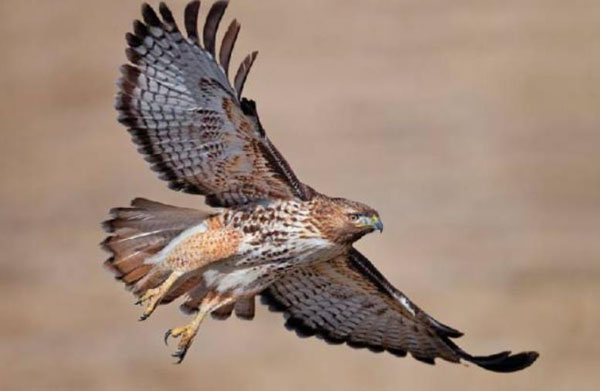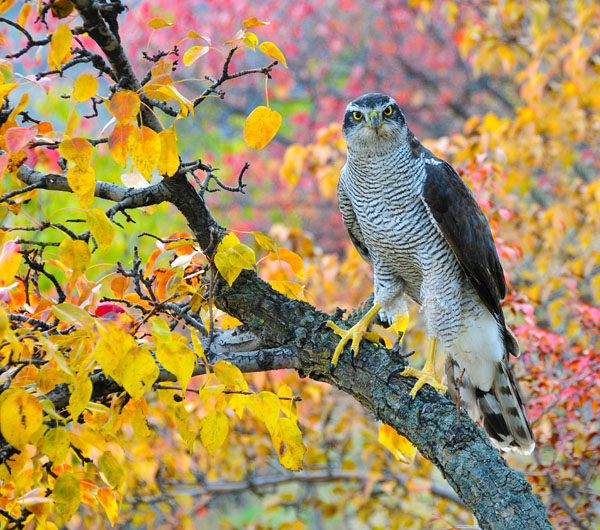Accipiter gentilis
IUCN
LCBasic Information
Scientific classification
- name:Accipiter gentilis
- Scientific Name:Goshawk, hawk, yellow hawk, harrier hawk
- Outline:Raptor
- Family:Accipitriformes Accipitridae Accipiter
Vital signs
- length:60-130cm
- Weight:0.5-2.2kg
- lifetime:70 year
Feature
It is the largest member of the genus Eagle, with short, broad wings and long tail feathers.
Distribution and Habitat
It lives in woodlands, flies fast, and preys on small and medium-sized birds and small mammals. In China, it has been known as a star hunter in falconry since ancient times. The hunting temperament of the goshawk is flexible and fierce, and its attack is extremely explosive. It can not only catch small sparrows and mice in the dense forest, but also "fight big with small" to kill hares and grouse in the wilderness that weigh much more than itself. It even often actively attacks other birds of prey, especially owls. The goshawk has a wide hunting range, which can reach 5-64 square kilometers. Before and after the breeding season when food is abundant, the hunting range will be reduced, and the hunting range will be greatly expanded in winter. Summer migratory birds are found in the forested areas of Northeast Xinjiang, and may also be found in the Hengduan Mountains. During migration, they pass through the eastern region and winter in the south. Worldwide, its natural distribu
Appearance
A medium-sized bird of prey. It is large and strong, with females significantly larger than males. Six wing fingers are visible when this species is flying. The plumage of males and females is similar. The plumage of adult individuals is similar to that of sparrowhawks, but the head is smaller, the body is stronger, and the tail is shorter. The wing tips are more pointed than those of sparrowhawks, and the base color of the chest and abdomen is whiter. A large number of very fine dark horizontal stripes can be seen. The back and the top of the head are dark in color, and it looks like a "helmet" from a distance. Many individuals can be observed with clear white eyebrows and a slightly protruding wedge-shaped tail in the center. The wings of the goshawk are not short and round like those of the crested eagle, and there is no obvious midline of the throat and snow-white fluffy undertail coverts. The back of the immature bird is brown with irregular white spots, and the base col
Details
The goshawk is a carnivorous bird of prey in the forest. It has sharp vision and is good at flying. It is active during the day. It is very alert and good at hiding. It usually moves alone and has a sharp and loud cry. When soaring in the air, its wings are stretched horizontally or slightly raised upwards, and occasionally accompanied by the flapping of its wings. However, except during migration, it rarely soars in the air. It often hides in the branches of the forest to spy on prey. It flies fast and flexibly. It can use its short round wings and long tail feathers to adjust speed and change direction. It can go up or down in the forest, high or low, and pass through the bushes. It can also increase its flying speed to chase prey in the woods. Sometimes it also flies over the open area at the edge of the forest or glides in a straight line to spy on the activities of animals on the ground. Once it finds prey such as rodents, hares, pheasants, hazel grouse, pigeons and other small and medium-sized birds in the forest, it will dive quickly, chase in a straight line, and catch the prey with its sharp claws. Although its weight is about one-fifth lighter than other medium-sized birds of prey, its speed is more than three times faster. When it stretches out its claws to strike its prey, its speed is 22.5 meters per second. Therefore, its hunting characteristics are fierce, accurate, ruthless and fast, and it has great lethality. It will pounce on any animal within its reach, pierce its chest with the claws on one foot, and then cut open its abdomen with the claws on the other foot. It will first eat the tender heart, liver, lungs and other internal organs, and then bring the bloody corpse back to the tree where it lives, tear it apart and peck it.

The goshawk is active and foraging during the day. They mainly prey on other small birds and mammals, often flying in groups, crossing dense forests, and launching surprise attacks on prey. Like most birds of prey, goshawks are also "opportunists" and will attack as long as they see suitable prey. But they still have a special liking for birds, especially ruffed grouse, bird species of the order Tailtail, and starlings in the order Passeriformes. Among water birds, birds smaller than mallards are also their targets. In addition, goshawks occasionally catch some larger animals, such as snow rabbits and long-eared rabbits.

They are territorial and do not like any intruders. Even passing humans will be driven away fiercely by them. Therefore, their eggs or young birds are rarely preyed on. Goshawks are occasionally attacked by raptors such as eagle owls and buzzards.
It is mainly a summer and winter migratory bird in China, and mostly a passing bird in the central and eastern regions. The migration time is from March to April in spring and from October to November in autumn.
In the 19th century, goshawks became extinct in the UK because they were favored by collectors and hunted by local gamekeepers, but in recent years many goshawks from continental Europe have re-immigrated to the UK. They have been found in the Caird Forest in Northumberland, England.








